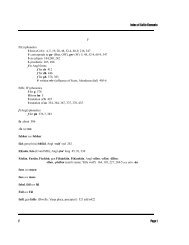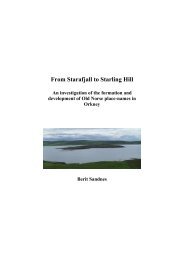May Williamson: The Non-Celtic Place-Names of the Scottish Border ...
May Williamson: The Non-Celtic Place-Names of the Scottish Border ...
May Williamson: The Non-Celtic Place-Names of the Scottish Border ...
You also want an ePaper? Increase the reach of your titles
YUMPU automatically turns print PDFs into web optimized ePapers that Google loves.
33<br />
<strong>The</strong> names in -feld, MSc, -feild, are not found to any marked extent in <strong>the</strong> same districts as <strong>the</strong><br />
names in -lēah, but are dispersed throughout <strong>the</strong> entire area.<br />
<strong>Names</strong> ending in -field <strong>of</strong> patently modern origin occur in clusters in <strong>the</strong> <strong>Border</strong> counties, eg<br />
Jeaniefield (Mel), Kittyfield (Mel), Grizziefield (Earl), Rachelfield (Earl). <strong>The</strong>se must be<br />
field-names transferred to farms.<br />
In <strong>the</strong> earliest names below, <strong>the</strong> meaning <strong>of</strong> <strong>the</strong> terminal may be “stretch <strong>of</strong> open country”. In<br />
<strong>the</strong> later examples it has already become “enclosed land”, or simply <strong>the</strong> modern meaning <strong>of</strong><br />
“field”.<br />
ROXBURGHSHIRE<br />
HENFIELD (Oxn): (86, 7 B):<br />
Hynehousfeild, 1566 RMS; Henhousfield, 1588 L Ch. It is not certain whe<strong>the</strong>r <strong>the</strong> above<br />
spellings /80/ refer to Henfield. <strong>The</strong>y may represent “hind-house-field”, where hind denotes a<br />
farm-worker. O<strong>the</strong>rwise <strong>the</strong> name must be fairly modern.<br />
SORROWLESSFIELD (MAINS) (Mel): (81, 1 C):<br />
Sorulesfeld, 1208 LSMM; Sorweles-, 1215 ib. This land was held by Willielmus Sorules who<br />
gave his name to it (LSMM i, 90).<br />
STOTFIELD (Jed):<br />
Stobfold, Blaeu. Blaeu’s spelling must mean “a fold, or pen, made <strong>of</strong> tree trunks”. <strong>The</strong> present<br />
form means “a field in which stotts (3 year old bulls or oxen) are kept”. <strong>The</strong> name may<br />
however be Stotfold, which is common in English place-names: cf Stotfold (PN Beds, Hu,<br />
178) and Stotfold, YWR (DEPN, 426).<br />
BERWICKSHIRE<br />
JARDINEFIELD (Wht):<br />
Jardinfeld, 1476 HMC (Wed). In <strong>the</strong> document quoted, John Jardin <strong>of</strong> Appilgarth sells his<br />
lands <strong>of</strong> Jardinfeld to George Hume <strong>of</strong> Wedderburn. Plainly <strong>the</strong> place was named from his<br />
family.<br />
NORTHFIELD (Cld), is so spelt in 1621 HMC (Wed). “North field”.<br />
SHIELFIELD (Earl):<br />
Scheilfeild, 1537 Dryb; Sheelfield, Blaeu. ME Schele feild, “land with a hut on it”.<br />
/81/<br />
SWANSFIELD (Cld): (75, 10 G):<br />
Swanisfield, 1546 HMC (Var Coll v); Swannisfeild, 1580 RMS; Swansfeld, 1595-6 HMC<br />
(Wed). A ME personal name Swan(n), from OE swān, “herdsman” is <strong>the</strong> first element.<br />
WHITFIELD (Ayt):<br />
Quhytfield, 1557 HMC (Home). “White field”.<br />
DUMFRIESSHIRE




